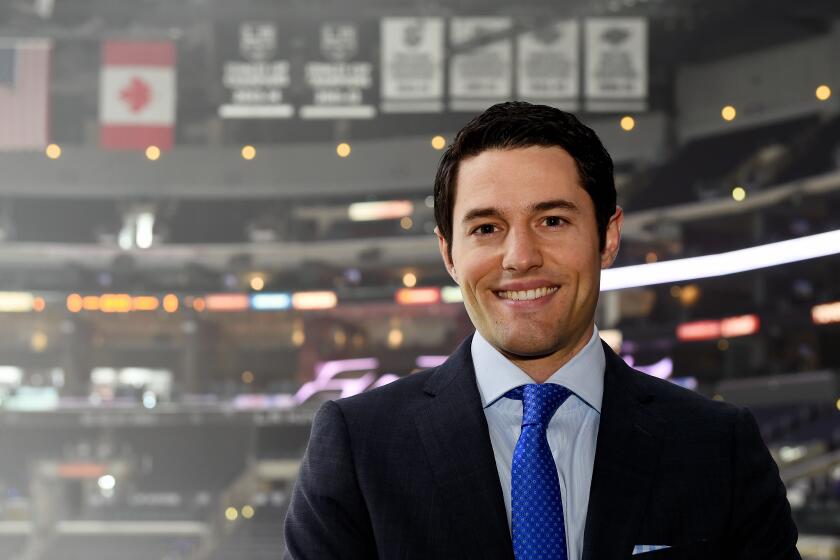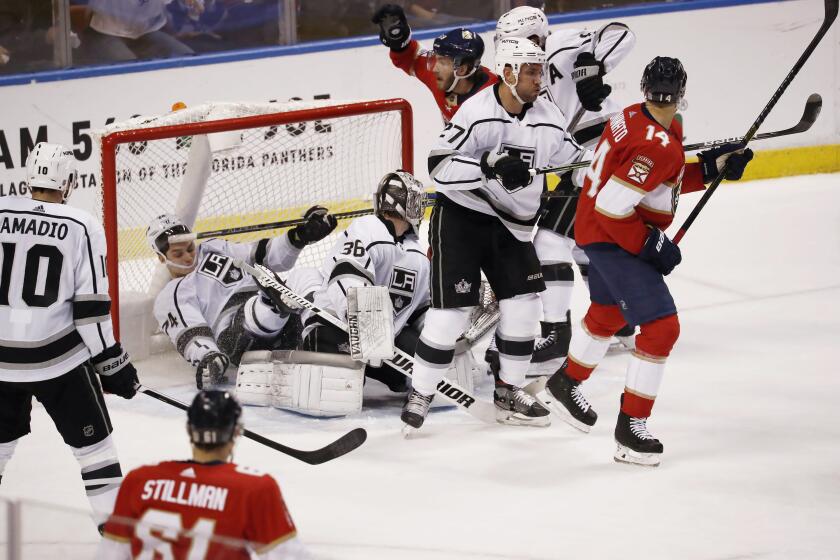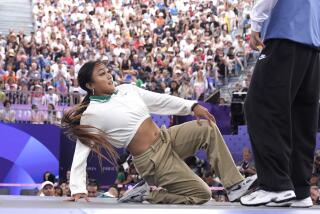NHL is making a push to increase its Latino fan base
- Share via
Stefan Jarrín circled the Staples Center concourse and found his seat in Section 119. His viewpoint was perfect. A sight line straight down the Kings’ blue line. An elevated perch, several rows off the glass, from which he followed the puck like a hawk, his eyes darting back and forth as play pinballed around the ice.
Jarrín has been a hardcore hockey fan since the 2009-10 season, when his Montreal-born father-in-law pushed him to dip a toe in the sport. That spring, the Kings went to playoffs for the first time in almost a decade, and by the time they were eliminated in the first round, Jarrín had dove head-first into full-fledged fandom.
“I just got totally hooked,” he said, mesmerized by the sport now as much as ever. “It was something different for me.”
Jarrín’s recent trip to Staples Center, for the Kings’ Latino Heritage Night on Jan. 6, ranks among his favorite memories. For the first time, his grandfather joined him to watch his new favorite sport. For the first time, Jaime Jarrín saw the NHL with his own eyes too.
“He loved it,” Stefan, 29, said of his 84-year-old grandfather, the Hall-of-Fame Spanish-radio broadcaster for the Dodgers. “Seeing it in person — the balance, the hand-eye coordination, everything — he had such a great time.”
Legends replaced: Alex Faust takes over for Kings’ Bob Miller, Joe Davis for Dodgers’ Vin Scully, and Brian Sieman for Clippers’ Ralph Lawler.
During one of the intermissions, Jaime joined the Fox Sports West set with a wide smile.
“He’s trying to teach me some details of the game,” Jaime said of his grandson. “But the atmosphere is fantastic.”
Jaime, who is entering his 62nd season calling Dodgers games, is from Ecuador. Stefan, a former minor league baseball player, was born and raised in Southern California. But both are members of a Latino community that the NHL, and the hockey world at-large, is making renewed efforts to reach; a demographic with which the sport, seemingly now more than ever, is deliberately trying to connect.
“There’s this momentum across the league and the hockey industry itself,” said Alicia Chin, an NHL senior manager of social impact and growth. “As demographics of North America are changing, we know that we need to be relevant.”
The traditional cold-weather sport has never found much of a foothold in Latin America. In many cities across the U.S. Sun Belt states, it still remains mainly a niche activity. Latino players, such as the Kings’ Alec Martinez and Toronto Maple Leafs All-Star forward Auston Matthews, have always been in the minority on NHL rosters.
And unlike football and baseball, French is hockey’s de facto second language, not Spanish.
The potential, however, is promising. Teams across the league, especially those in the country’s southern footprint, are envisioning an increasingly diversified future for their sport. Stefan got to see it with his own eyes. One game was all it took to make a fan of his grandfather.
“He didn’t realize the athleticism that the players had,” Stefan said. “When you get there [and see] the speed that they play with. The hand-eye coordination. The ability to keep the puck on their stick without even having to look down and just always know where players are. Their ability to play along the boards. He was just completely amazed by that.”
::
Francisco X. Rivera’s connection to hockey can be traced through a series of firsts.
As a child growing up in Mexico City, he was first exposed to the sport through Nintendo video games in the ‘90s. The first game he saw in person was a meeting between U.S. and Russian national teams held in Mexico in 1994. He got his first Kings jersey in 1997, the vintage black and silver sweater with the Chevy-shaped logo that was a “very desired fashion item” among his friends.
After attending his first Kings game in 2012, Rivera — then an up-and-coming bilingual sports broadcaster — found that nothing beat seeing an NHL game in person. When the Kings asked him last season to handle their first Spanish-language radio broadcasts since the 1997-98 season, he embarked upon the job with big ideas that went far beyond the airwaves.
“I was like, ‘We have to be very genuine,’ ” said Rivera, who counts a consultant role for the Kings’ Latino outreach efforts among his many other broadcast responsibilities with the team and Fox Sports, where he has covered everything from soccer to Major League Baseball to the NFL.
“We can’t really follow what everyone else is doing,” he told the team. “Let’s try to be original. Let’s try to keep it respectful.”
The NHL is determined to make sure its intentions to reach new fans are seen as pure, and not as some veiled short-term cash grab.
“Part of it is, come check us out,” said Jonathan Lowe, the Kings’ senior vice president of business development and brand strategies. “And the other part of it is, how do we have a meaningful impact and authentic long-term presence in the community? We’re doing that across multiple groups in the market, but [the Latino community] has been a big focus.”
The Kings scored three goals in the third period, but came up just short against the Panthers in Florida.
For the Kings, who have determined that 41% of their “general fan base” and 24% of their ticket buyers come from a Hispanic background, that push has included many tangible efforts.
They have organized ball hockey programs in 25 YMCAs across the city, especially those in neighborhoods such as East L.A. that don’t have nearby ice rinks, to introduce children of varying backgrounds to the sport. They held a summer reading program with the team mascot, Bailey, at libraries around the city.
During their Dia de los Muertos (Day of the Dead) game earlier this season, FSW aired a “side by side” broadcast in Spanish that Rivera called.
The Ducks also provided a Spanish-only stream for the broadcast of their Dia de los Muertos game this season, as part of their own efforts to draw in a more diverse fan base.
“As we think toward the national broadcast [television] deal and local broadcast deals in the future, us growing our brand and our fan base within L.A.,” said Kelly Cheeseman, the Kings’ chief operating officer, “we’ve gotta get in the weeds on some things that take a little time to build.”
The Kings have tried to be strategic about using social media. One example: This past summer, Rivera presented Mexican soccer icon and Club America coach Miguel Herrera with a Kings jersey (which Herrera requested bore No. 23 in honor of Dustin Brown).
Rivera said once the photo began circulating on social media — especially Facebook, which he noted is “a very effective tool for Latinos” — fans of the popular Mexican soccer club began commenting about the Kings. Some told Rivera the NHL team should host a “Club America night.” Enough small ripples like that, Rivera believes, can have the profound impact hockey teams are trying to produce.
“We started creating conversation, a buzz,” he said. “It didn’t go viral, but it got a good response. … Having those leaders around you and having those conversations will give you that genuine piece that you need.”
Teams in other markets have taken similar, yet specialized approaches.
The Arizona Coyotes became the first NHL team to have a Hispanic majority owner when Alex Meruelo, a Cuban-American, acquired a controlling interest in the club last July.
At his introductory news conference, Meruelo answered questions in English and Spanish, and under his leadership the Coyotes this season launched Spanish social media accounts and established a Hispanic advisory board — which is comprised of members from local Spanish television stations, the Arizona Hispanic Chamber of Commerce, and a Hispanic civil rights group, among others.
“I think, historically, hockey has been a little sheltered, a little exclusive,” said Coyotes President and CEO Ahron Cohen, whose team resides in a county that was more than 30% Hispanic according to 2018 Census Bureau data.
“It comes to being in a non-traditional market. Not everybody grew up playing hockey and knowing all the rules of hockey. … That is a market that has not connected with the sport or with this team historically. And what I’m very excited is, we have a tremendous opportunity to really move this forward.”
The Vegas Golden Knights, another innovator of outreach initiatives, were afforded a different approach. As an expansion club that began play in 2017, they were able to include Latino-focused efforts into their DNA from the start.
“We want everybody to feel like they belong, they’re part of the family,” said Brian Killingsworth, a senior vice president and chief marketing officer for the Golden Knights.
The Ducks, Golden Knights and Coyotes have helped get street hockey equipment into local area schools so the sport can be taught in gym classes, and have hosted learn-to-play clinics in predominately Hispanic areas.
“Rather than invite people just to T-Mobile [Arena],” Killingsworth said of the Golden Knights’ home venue along the Las Vegas Strip, “we needed to go out to the Hispanic population ourselves.”
On a league-wide level, this season has seen the creation of a Spanish-language version of the NHL’s website and the league’s first Hispanic Heritage Month last September to October.
“We really want to demonstrate how hockey can be a vehicle to improve communities, whether it’s fitness, the values that our sport teaches,” Chin said. “To come about it in a collaborative manner that suits both the hockey, in terms of bringing new fans in, but also making sure we are serving the needs of those communities.”
::
Speaking by phone from Washington — where she was working on the league’s Black Hockey History Tour — Chin took a deep breath when asked, even in light of the sport’s seemingly strong intentions to build a lasting relationship with the Latino community, whether all of this would actually work?
“That’s a great question,” she said. “You have to be optimistic.”
Chin pointed to the league’s hiring of Kim Davis in 2017 as executive vice president of social impact and growth initiatives as a turning point in these efforts. Davis, Chin said, pushed clubs to “think strategically about how to do outreach and make sure that our sport is seen and truly felt as being inclusive.”
Chin also credited the teams themselves — not just those in notable Latino markets, but across the continent — for finding ways to fulfill the needs in each of their cities.
“Where in the past there might have piecemeal initiatives and efforts,” Chin said, “I think now the whole hockey industry is coming together to work together.”
Slowly, there are signs that these efforts are making a difference.
With the Kings, Rivera said much of the fan response he receives from his Spanish broadcasts — the Kings had 10 such broadcasts last season and plan 12 this season — actually comes from the children and grandchildren of Latin American immigrants. Some don’t even speak Spanish but appreciate the recognition of their culture.
“A lot of that, in our view, is probably driven by some of the second-generation Hispanic Kings fans that we have helping us push that initiative,” Cheeseman said. “There was a big population of our fanbase that was already here that helps us build this.”
Rivera, who also handles Spanish-language broadcasts for LAFC, has found similarities between hockey and soccer as well, likening the speed of their games and the spirited spectacle of the stands in each.
In Vegas, Killingsworth said the Golden Knights have noticed a similar trend. The team has found that much of its Latino fanbase overlaps with that of the local professional soccer team, Las Vegas Lights FC.
“It’s really easy, if you’re a fan of soccer, to become an immediate fan of hockey,” Killingsworth said.
But for now, any metrics beyond positive anecdotal evidence are hard to accurately pin down. Only in time will those in hockey know if they’ve actually cultivated a new generation of Latino fans.
After all, the NHL’s teams maintain that they aren’t simply chasing short-term ticket sales and short-lived involvement in those communities. They are trying to recreate the magic that Rivera felt when he walked into Staples Center in 2012, that Stefan Jarrín felt following that first Kings playoff run in 2010, that Jaime Jarrín felt this month with his grandson by his side.
Latino fans “want to follow a sport where there’s a lot of pride and passion,” Stefan said. “That’s what you get out of hockey. You get a lot of pride, whether it’s from the fanbase, whether it’s from the team. You get a lot of passion out of the players every game. I think as they continue to market and they continue to expose your non-traditional hockey fan to the game of hockey, I think it’s just going to grow.”
More to Read
Go beyond the scoreboard
Get the latest on L.A.'s teams in the daily Sports Report newsletter.
You may occasionally receive promotional content from the Los Angeles Times.









